Optimization Design of Large-Aperture Primary Mirror for a Space Remote Camera
Abstract
1. Introduction
2. Optical System Design
2.1. Focal Length of the Optical System
2.2. Diameter of the Primary Mirror
2.3. Design Requirements
3. Design of Initial Parameters of the Primary Mirror
3.1. Primary Mirror Materials
3.2. Initial Structural Design of the Primary Mirror
3.3. Improvement Structure Based on the Manufacturing Process of the Mirror Blank
4. Optimization Design of the Primary Mirror
4.1. Optimization Mathematical Model Based on Compromise Programming Theory
4.2. Design of the Primary Mirror and Flexible Hinge
4.3. Optimization Results
5. Engineering Analysis
5.1. Static Analysis
5.2. Dynamic Analysis
5.2.1. Modal Analysis
5.2.2. Frequency Response Analysis
6. Experimental Verification
6.1. Surface Shape Error Testing of the Primary Mirror
6.2. Mechanical Vibration Test of the Primary Mirror Assembly
7. Conclusions
Author Contributions
Funding
Institutional Review Board Statement
Informed Consent Statement
Data Availability Statement
Conflicts of Interest
References
- Esper, J.; Neeck, S.; Slavin, J.A.; Wiscombe, W.; Bauer, F.H. Nano/Micro Satellite Constellations for Earth and Space Science. Acta Astronaut. 2003, 52, 785–791. [Google Scholar] [CrossRef]
- Underwood, C.; Pellegrino, S.; Lappas, V.J.; Bridges, C.P.; Baker, J. Using CubeSat/micro-satellite technology to demonstrate the Autonomous Assembly of a Reconfigurable Space Telescope (AAReST). Acta Astronaut. 2015, 114, 112–122. [Google Scholar] [CrossRef]
- Kouhei, Y.; Hosei, N. Development of a heat storage panel for micro/nano-satellites and demonstration in orbit. Appl. Therm. Eng. 2015, 91, 894–900. [Google Scholar]
- Wang, K.; Dong, J.; Zhao, Y.; Chi, C.; Jiang, P.; Wang, X. Research on high performance support technology of space-based large aperture mirror. Optik 2021, 226, 165929. [Google Scholar] [CrossRef]
- Liu, X.; Tian, X.; Zhang, W.; Zhang, B.; Cheng, Z.; Fu, L.; Wang, Z. Lightweight design of high volume SiC/Al composite mirror for remote camera. Optik 2019, 188, 64–70. [Google Scholar] [CrossRef]
- Hu, R.; Liu, S.T.; Li, Q.H. Topology-optimization-based design method of flexures for mounting the primary mirror of a large-aperture space telescope. Appl. Opt. 2017, 56, 4551–4560. [Google Scholar] [CrossRef]
- Zhang, M.; Lu, Q.; Tian, H.; Wang, D.; Chen, C.; Wang, X. Design and optimization for mounting primary mirror with reduced sensitivity to temperature change in an Aerial Optoelectronic Sensor. Sensors 2021, 21, 7993. [Google Scholar] [CrossRef] [PubMed]
- Qu, Y.; Jiang, Y.; Feng, L.; Li, X.; Liu, B.; Wang, W. Lightweight Design of Multi-Objective Topology for a Large-Aperture Space Mirror. Appl. Sci. 2018, 8, 2259. [Google Scholar] [CrossRef]
- Liu, F.; Li, W.; Zhao, W.; Zhao, H.; Lin, G.; Wang, X. Topology Optimization Based Parametric Design of Balloon Borne Telescope’s Primary Mirror. Appl. Sci. 2021, 11, 5077. [Google Scholar] [CrossRef]
- Qin, T.; Guo, J.; Jing, Z.; Han, P.; Qi, B. Hybrid IPSO-IAGA-BPNN algorithm-based rapid multi-objective optimization of a fully parameterized spaceborne primary mirror. Appl. Opt. 2021, 60, 3031–3043. [Google Scholar] [CrossRef] [PubMed]
- Li, Z.X.; Chen, X.; Wang, S.J.; Guang, J. Optimal design of a Φ760 mm lightweight SiC mirror and the flexural mount for a space telescope. Rev. Sci. Instrum. 2017, 88, 125107. [Google Scholar] [CrossRef]
- Hagyong, K.; Ho-Soon, Y. Design optimization of a 1m lightweight mirror for a space telescope. Opt. Eng. 2013, 52, 091806. [Google Scholar]
- Liu, S.; Hu, R.; Li, Q.; Zhou, P.; Dong, Z.; Kang, R. Topology optimization-based lightweight primary mirror design of a large-aperture space telescope. Appl. Opt. 2014, 53, 8318–8321. [Google Scholar] [CrossRef]
- Bittner, H.; Erdmann, M.; Haberler, P.; Zuknik, K.H. Sofia primary mirror assembly: Structural properties and optical performance. In Airborne Telescope Systems II; SPIE: Bellingham, DC, USA, 2003; Volume 4857, pp. 266–273. [Google Scholar]
- Zhang, X.; Hu, H.; Wang, X.; Luo, X.; Zhang, G.; Zhao, W.; Wang, X.; Liu, Z.; Xiong, L.; Qi, E.; et al. Challenges and strategies in high-accuracy manufacturing of the world’s largest SiC aspheric mirror. Light Sci. Appl. 2022, 11, 310. [Google Scholar] [CrossRef] [PubMed]
- Yoder, P. Opto-Mechanical Systems Design; Marced Dekker Inc.: New York, NY, USA, 1993. [Google Scholar]
- Friedman, E. Photonics Rules of Thumb; McGraw Hill: NewYork, NY, USA, 2003. [Google Scholar]
- JongIn, B.; Haeng, B.L.; Jeong, W.K. Design of All-SiC Lightweight Secondary and Tertiary Mirrors for Use in Spaceborne Telescopes. Curr. Opt. Photonics 2022, 6, 60–68. [Google Scholar]
- Petrovsky, G.T.; Tolstoy, M.N. 2.7-meter-diameter silicon carbide primary mirror for the SOFIA telescope. Proc. SPIE 1994, 2199, 263–270. [Google Scholar]
- Kaneda, H. Cryogenic optical performance of the ASTRO-F SiC telescope. Appl. Opt. 2005, 44, 6823–6832. [Google Scholar] [CrossRef]
- Sholl, M.; Lampton, M. Snap Telescope: Optical, Infrared, and Millimeter Space Telescopes. Proc. SPIE 2004, 5487, 1473–1483. [Google Scholar]
- Liu, J.Z.; Jiang, B. Topology optimization design of a space mirror. Proc. SPIE 2015, 9795, 665–674. [Google Scholar]
- Andrew, F.; Tom, H.; Mary, E.; Matthew, A.; Kent, S. ULE design considerations for a 3m class light weighted mirror blank for EELT M5. Proc. SPIE Int. Soc. Opt. Eng. 2016, 9912, 1062–1071. [Google Scholar]
- Hu, J.N.; Dong, J.H.; Zhou, P.W. Parametric design of flexure supporting for optical space remote sensor primary mirror. Acta Opt. Sin. 2016, 36, 297–304. [Google Scholar]
- Taimoor, I.; Wang, L.; Li, D.C.; Dong, E.C.; Fan, H.B.; Fu, J.; Hu, C. A general multi-objective topology optimization methodology developed for customized design of pelvic prostheses. Med. Eng. Phys. 2019, 69, 8–16. [Google Scholar]
- Teimouri, M.; Asgari, M. Multi-objective BESO topology optimization for stiffness and frequency of continuum structures. Struct. Eng. Mech. 2019, 72, 181–190. [Google Scholar]
- Li, A.; Wang, W.; Bian, Y.; Liu, L. Dynamic characteristics analysis of a large-aperture rotating prism with adjustable radial support. Appl. Opt. 2014, 53, 2220–2228. [Google Scholar] [CrossRef] [PubMed]
- Wang, K.J.; Dong, J.H.; Wang, X.Y.; Chi, C.Y. Design of frame-type support structure for space-based rectangular convex mirror tested on the back. Optik 2020, 212, 164673. [Google Scholar]


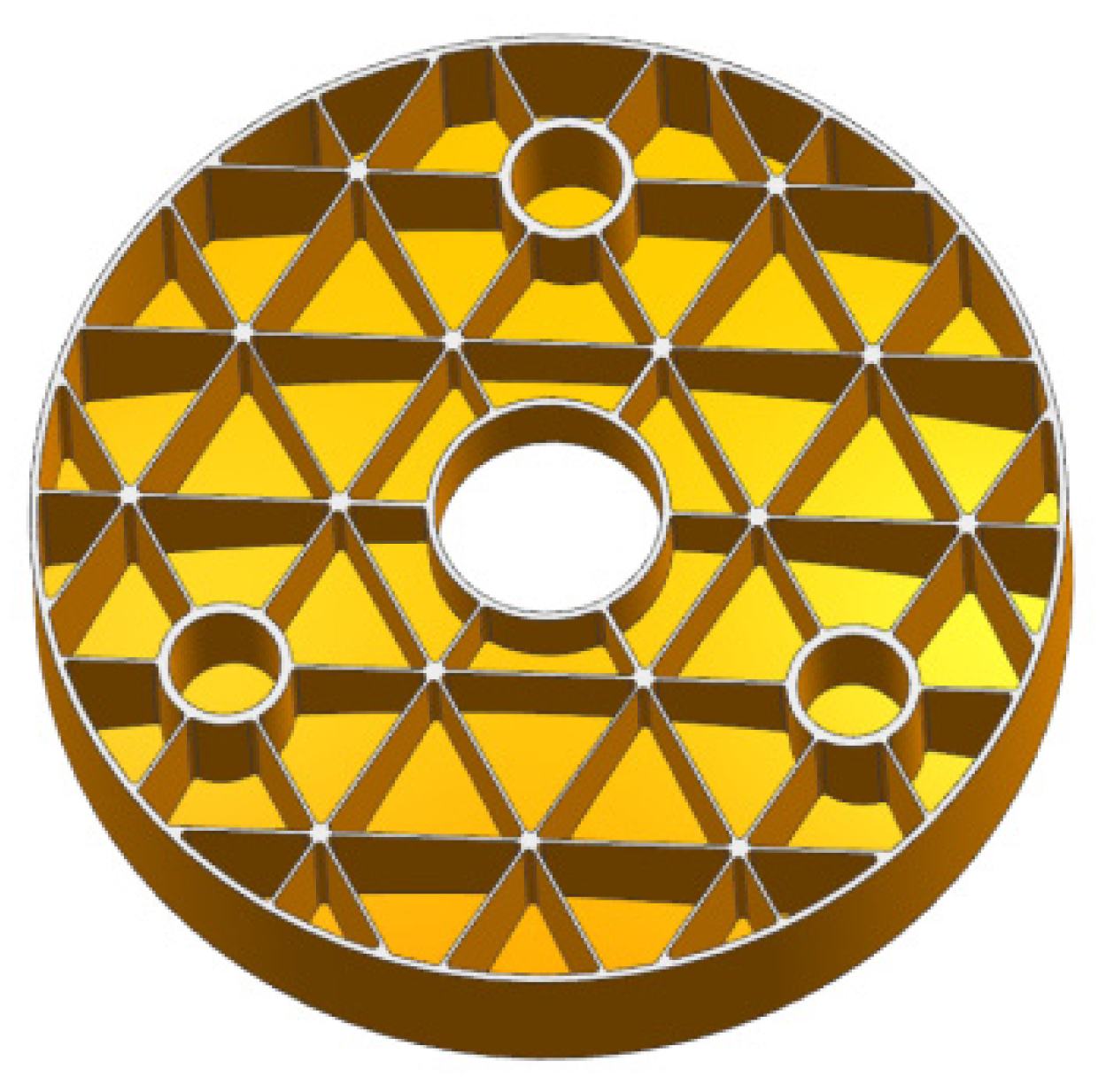
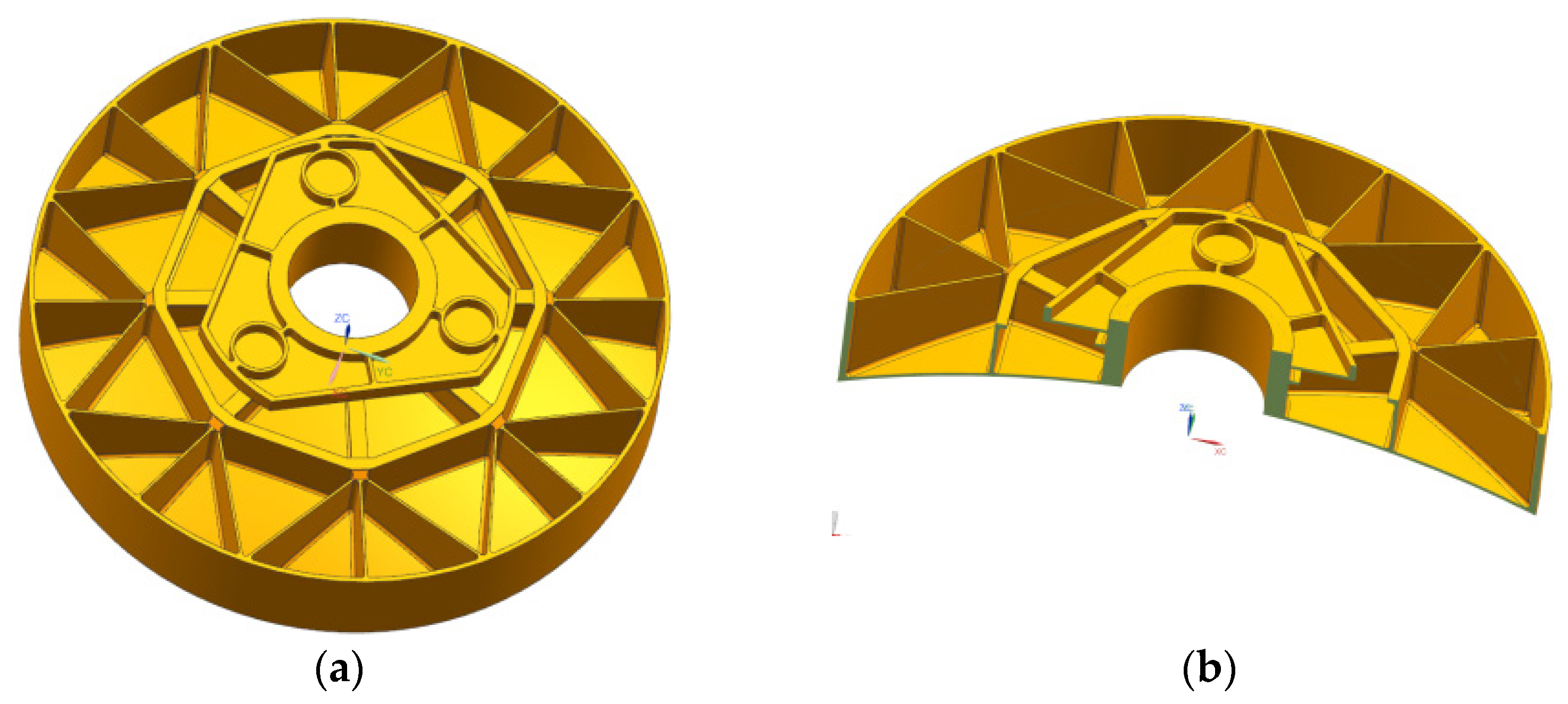
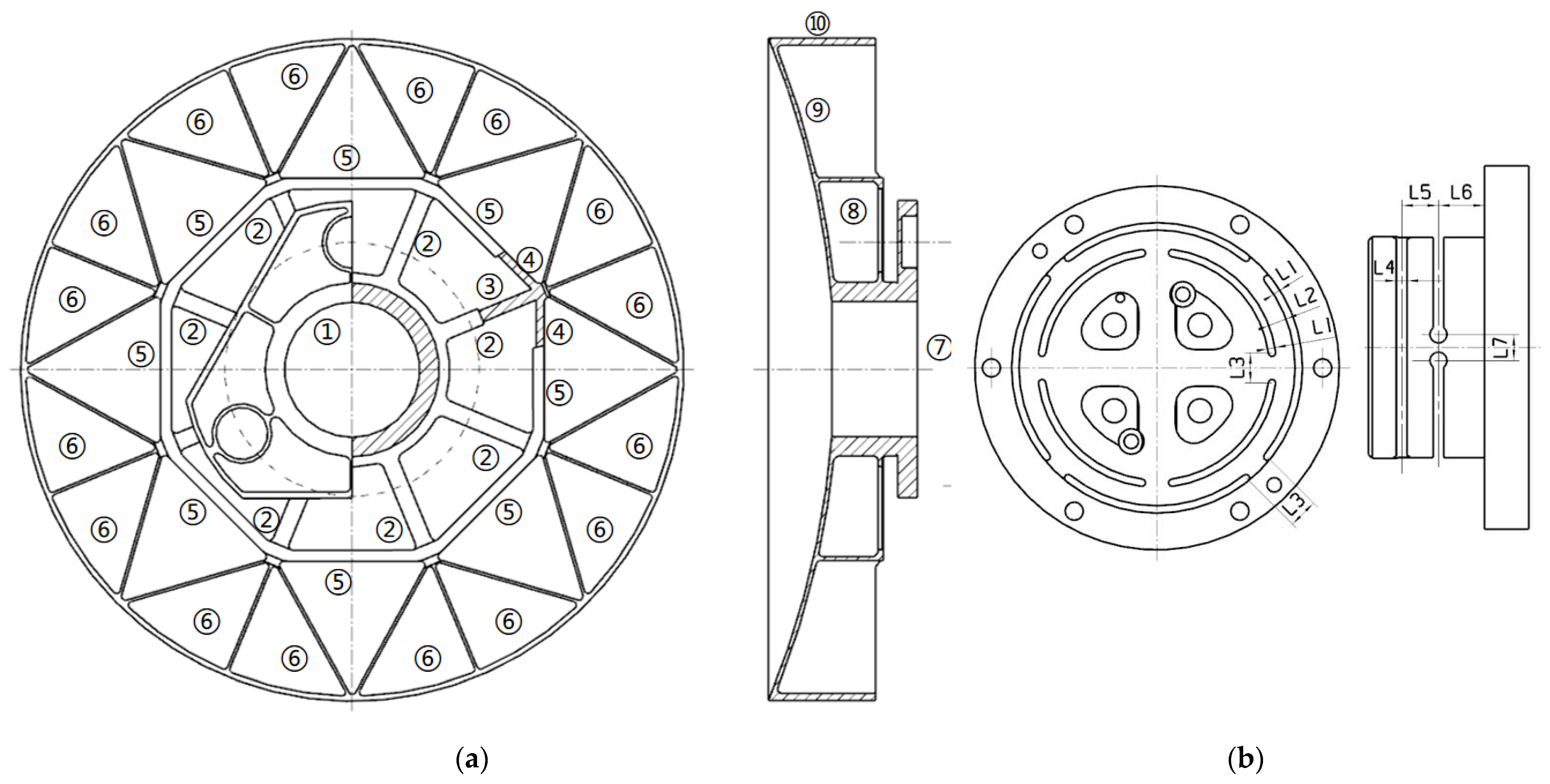
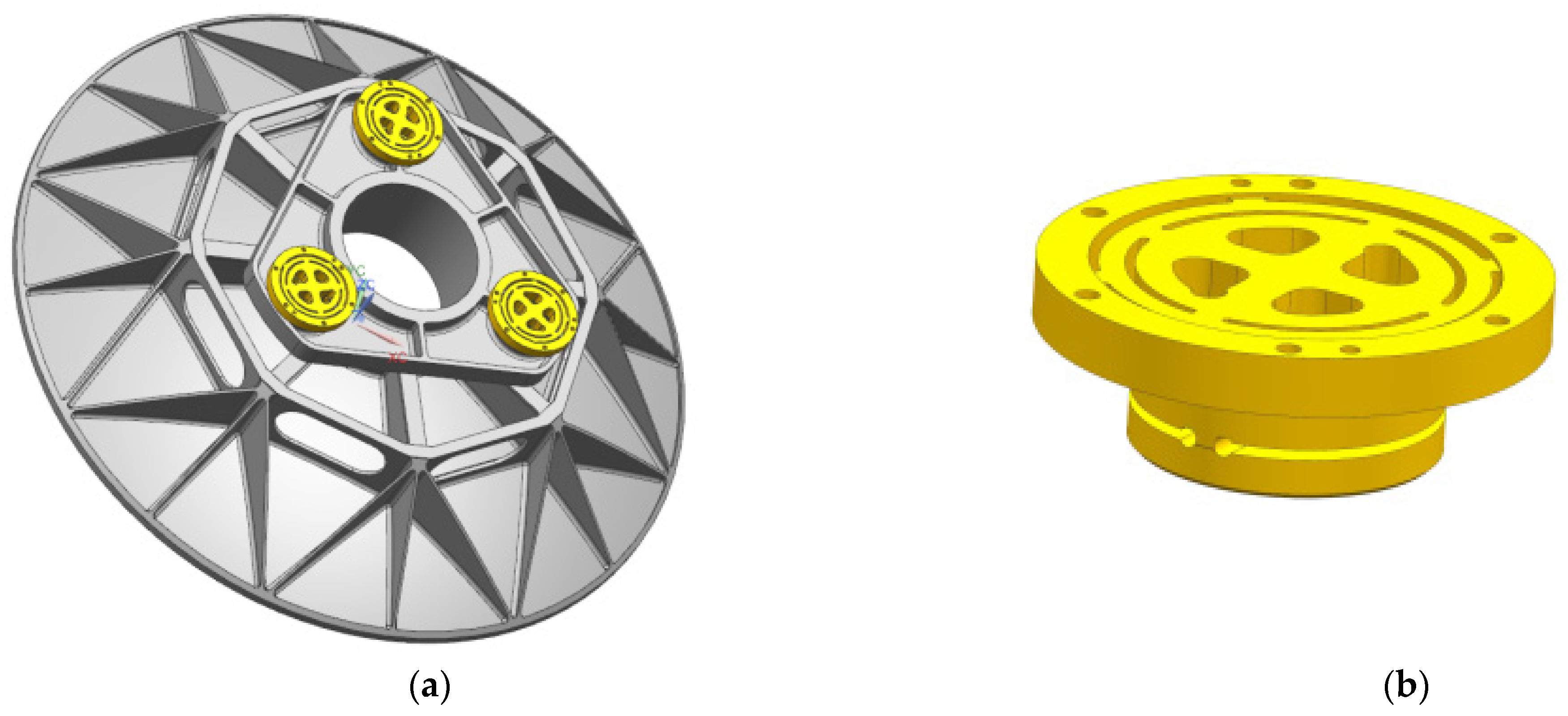
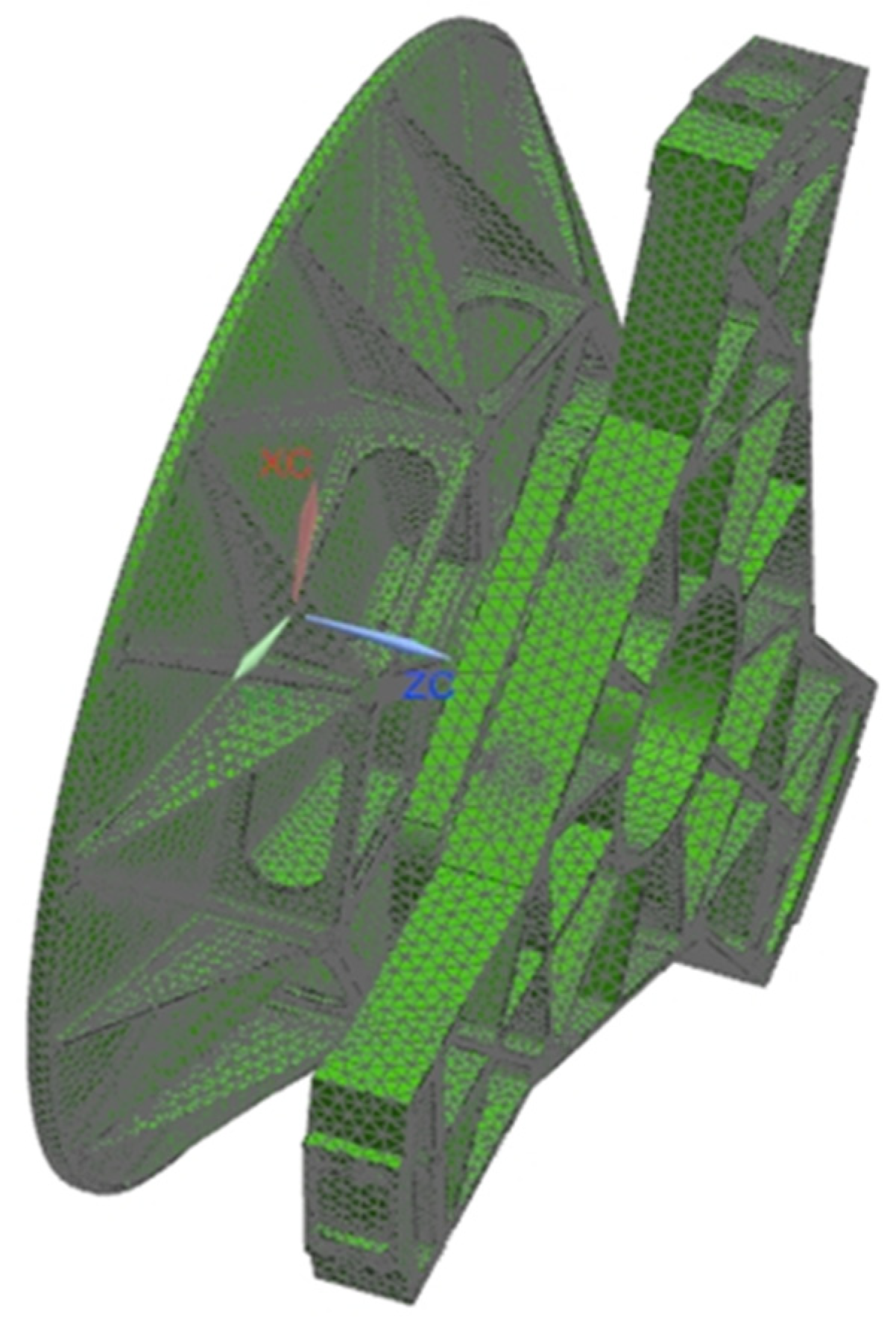
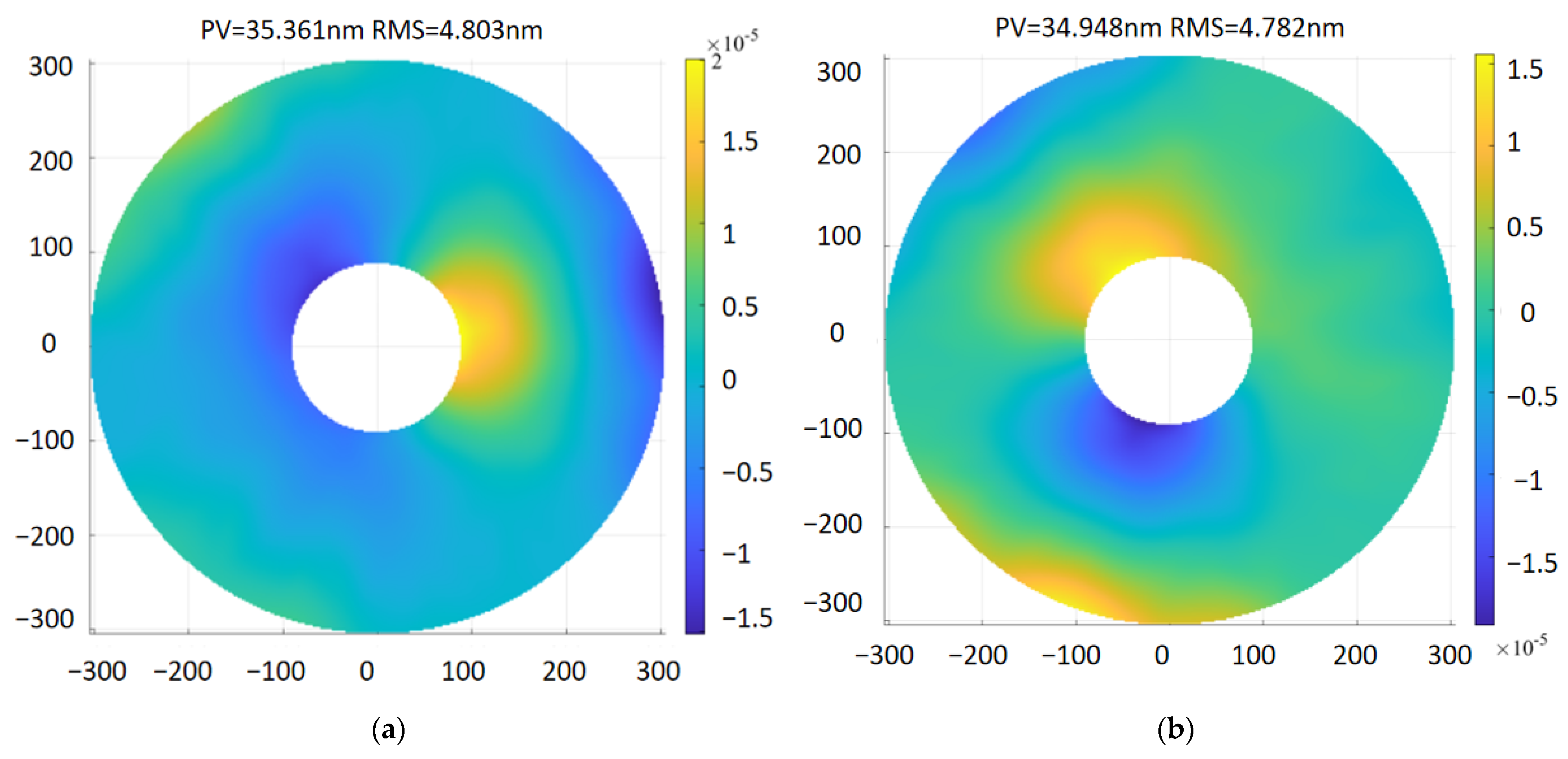
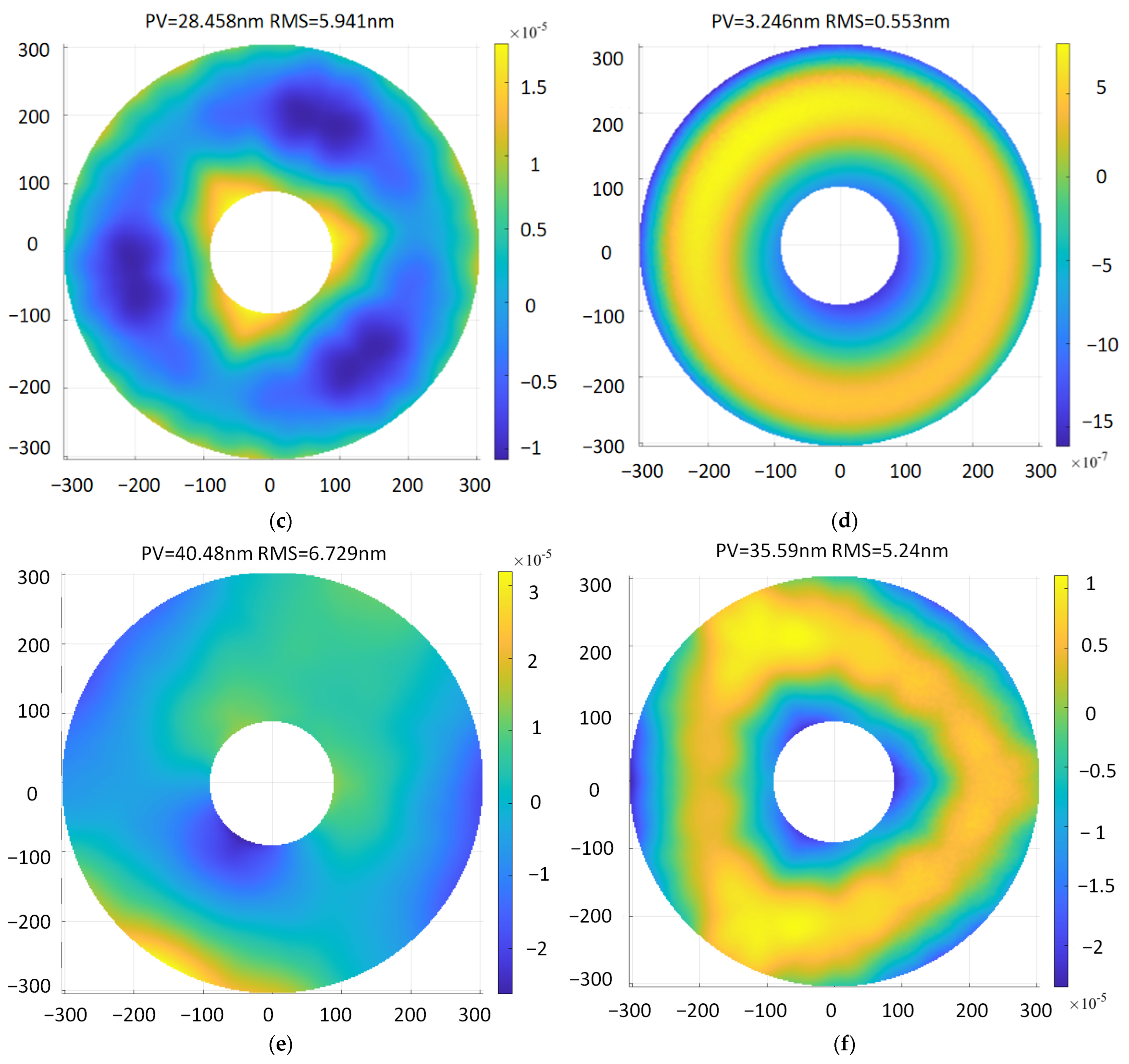
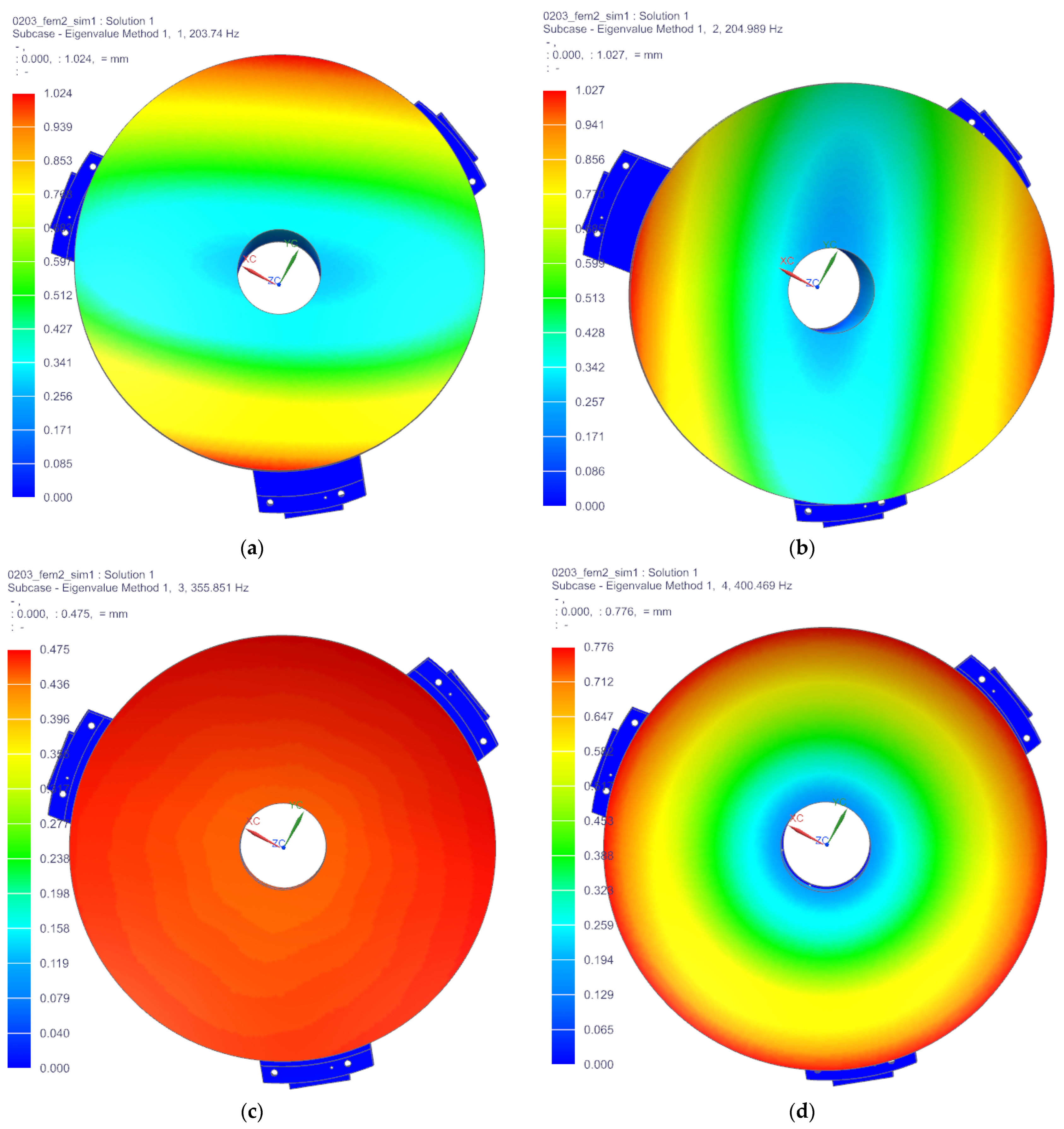

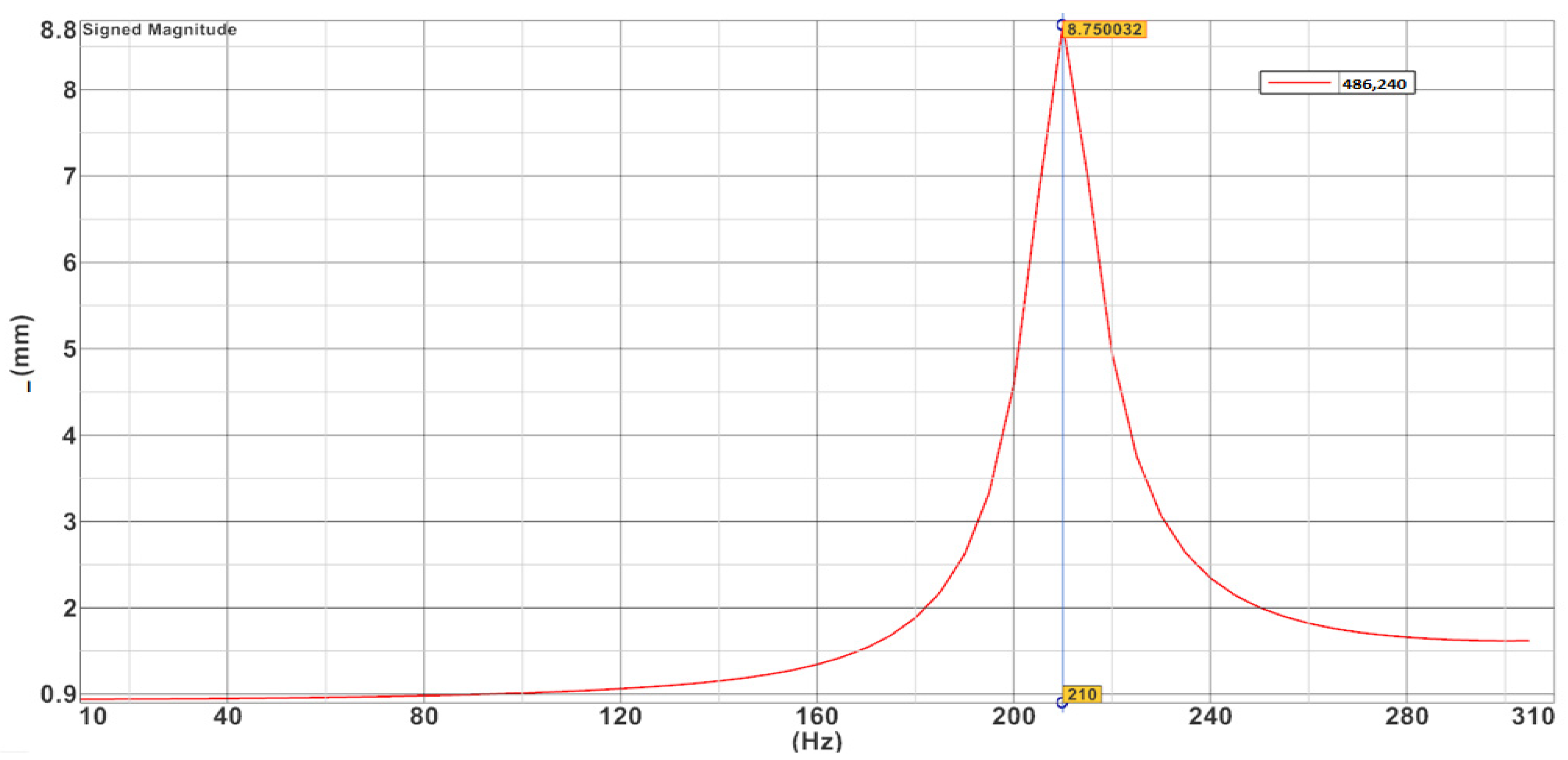

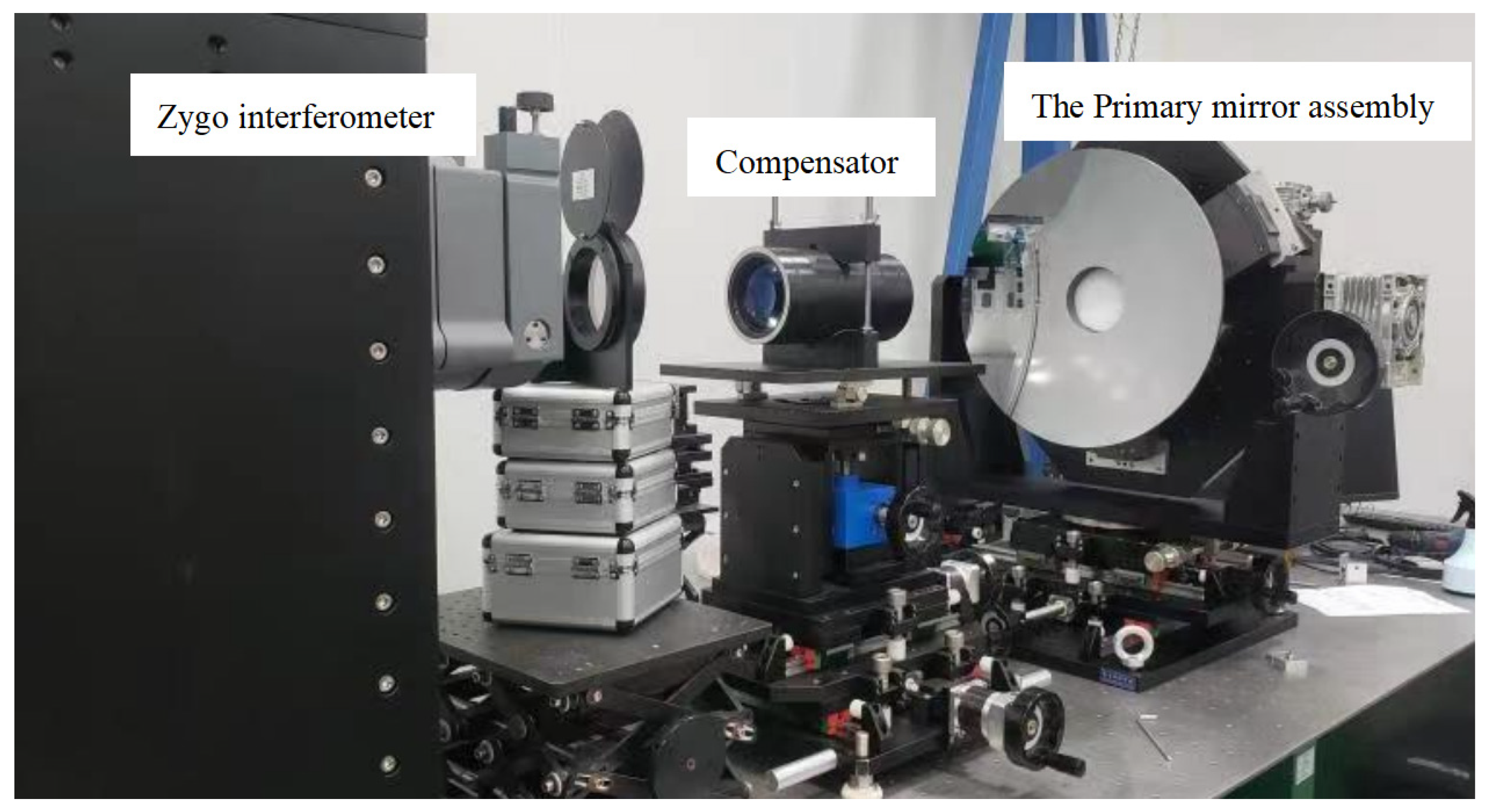


| Components | Value |
|---|---|
| The Primary Mirror Mass | < |
| RMS Error Under Gravity (, , ) | < (12.6 nm, ) |
| RMS error under uniform temperature rise 4 °C | < (12.6 nm) |
| RMS error under 0.01 mm planeness error | < (12.6 nm) |
| PV error under gravity | < (63.3 nm) |
| Fundamental frequency | > |
| Operating temperature | 20 ± 4 °C |
| Primary mirror around X or Y inclination angle | <5″ |
| Linear Displacement of the Mirror Under 1 g Gravity | < |
| Components | Material | Young’ Modulus (Gpa) | Poisson’ Ratio | Density (g/cm3) | Coefficient of Thermal Expansion (10−6/K) |
|---|---|---|---|---|---|
| Primary mirror | SiC | 330 | 0.25 | 3.05 | 2.5 |
| Flexure | 4J32 | 141 | 0.28 | 8.1 | 2.5 |
| Variable | Domain (mm) | Original (mm) | Optimized (mm) |
|---|---|---|---|
| rib ① | 8 ≤ (1) ≤ 10 | 8 | 10 |
| rib ② | 10 ≤ (2) ≤ 15 | 13 | 10 |
| rib ③ | 2 ≤ (3) ≤ 5 | 3 | 4 |
| rib ④ | 2 ≤ (4) ≤ 5 | 3 | 3 |
| rib ⑤ | 6 ≤ (5) ≤ 10 | 10 | 8 |
| rib ⑥ | 2 ≤ (6) ≤ 3 | 3 | 2 |
| Diameter ⑦ | Φ260 ≤ (7) ≤ Φ350 | Φ350 | Φ308 |
| rib height ⑧ | 55 ≤ (8) ≤ 70 | 70 | 60 |
| Thickness ⑨ | 3 ≤ (9) ≤ 4 | 3 | 3 |
| rib height ⑩ | 3 ≤ (10) ≤ 70 | 5 | 4 |
| L1 | 1 ≤ (L1) ≤ 3 | 2 | 1.5 |
| L2 | 2 ≤ (L2) ≤ 6 | 6 | 3.5 |
| L3 | 3 ≤ (L3) ≤ 6 | 3 | 4 |
| L4 | 1 ≤ (L4) ≤ 3 | 3 | 1.5 |
| L5 | 5 ≤ (L5) ≤ 10 | 8 | 6.5 |
| L6 | 3 ≤ (L6) ≤ 5 | 5 | 3.5 |
| Loads | Surface Shape Error (nm) | Linear Displacement (um) | Inclination Angle (″) | ||||
|---|---|---|---|---|---|---|---|
| PV | RMS | Tx | Ty | Tz | Rx | Ry | |
| X gravity | 35.361 | 4.803 | 0 | 0.094 | 0.01 | 0.177 | 0 |
| Y gravity | 34.948 | 4.782 | 0.094 | 0 | 0 | 0 | 0.178 |
| Z gravity | 28.458 | 5.941 | 0 | 0 | 0.176 | 0.001 | 0 |
| 4 °C temperature rise | 3.246 | 0.553 | 1.007 | 1.670 | 0.935 | 0.033 | 0.036 |
| 0.01 mm assembly error in Y | 40.480 | 6.729 | 1.709 | 0.930 | 1.837 | 1.796 | 2.290 |
| 0.01 mm assembly error in Z | 35.59 | 3.24 | 0.011 | 1.572 | 4.854 | 2.860 | 0.024 |
| Design index | 63.3 | 12.6 | 10 | 10 | 10 | 5 | 5 |
| Order | Frequency/Hz | Vibration Mode |
|---|---|---|
| 1 | 203.74 | Rotate along X axis |
| 2 | 204.989 | Rotate along Y axis |
| 3 | 355.851 | Move along Z axis |
| 4 | 400.469 | Rotate along Z axis |
| 5 | 683.427 | Move along X axis |
| 6 | 684.067 | Move along Y axis |
Disclaimer/Publisher’s Note: The statements, opinions and data contained in all publications are solely those of the individual author(s) and contributor(s) and not of MDPI and/or the editor(s). MDPI and/or the editor(s) disclaim responsibility for any injury to people or property resulting from any ideas, methods, instructions or products referred to in the content. |
© 2023 by the authors. Licensee MDPI, Basel, Switzerland. This article is an open access article distributed under the terms and conditions of the Creative Commons Attribution (CC BY) license (https://creativecommons.org/licenses/by/4.0/).
Share and Cite
Liu, X.; Gu, K.; Li, M.; Cheng, Z. Optimization Design of Large-Aperture Primary Mirror for a Space Remote Camera. Sensors 2023, 23, 5441. https://doi.org/10.3390/s23125441
Liu X, Gu K, Li M, Cheng Z. Optimization Design of Large-Aperture Primary Mirror for a Space Remote Camera. Sensors. 2023; 23(12):5441. https://doi.org/10.3390/s23125441
Chicago/Turabian StyleLiu, Xiaohan, Kaihui Gu, Meixuan Li, and Zhifeng Cheng. 2023. "Optimization Design of Large-Aperture Primary Mirror for a Space Remote Camera" Sensors 23, no. 12: 5441. https://doi.org/10.3390/s23125441
APA StyleLiu, X., Gu, K., Li, M., & Cheng, Z. (2023). Optimization Design of Large-Aperture Primary Mirror for a Space Remote Camera. Sensors, 23(12), 5441. https://doi.org/10.3390/s23125441





